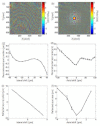Implementation of a digital optical phase conjugation system and its application to study the robustness of turbidity suppression by phase conjugation
- PMID: 20389354
- PMCID: PMC3378352
- DOI: 10.1364/OE.18.003444
Implementation of a digital optical phase conjugation system and its application to study the robustness of turbidity suppression by phase conjugation
Abstract
In this work, we report a novel high capacity (number of degrees of freedom) open loop adaptive optics method, termed digital optical phase conjugation (DOPC), which provides a robust optoelectronic optical phase conjugation (OPC) solution. We showed that our prototype can phase conjugate light fields with approximately 3.9 x 10(-3) degree accuracy over a range of approximately 3 degrees and can phase conjugate an input field through a relatively thick turbid medium (micro(s)l approximately 13). Furthermore, we employed this system to show that the reversing of random scattering in turbid media by phase conjugation is surprisingly robust and accommodating of phase errors. An OPC wavefront with significant spatial phase errors (error uniformly distributed from - pi/2 to pi/2) can nevertheless allow OPC reconstruction through a scattering medium with approximately 40% of the efficiency achieved with phase error free OPC.
Figures








References
Publication types
MeSH terms
Grants and funding
LinkOut - more resources
Full Text Sources
Other Literature Sources
Research Materials
Miscellaneous

